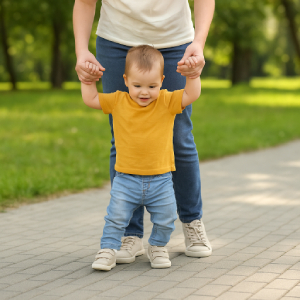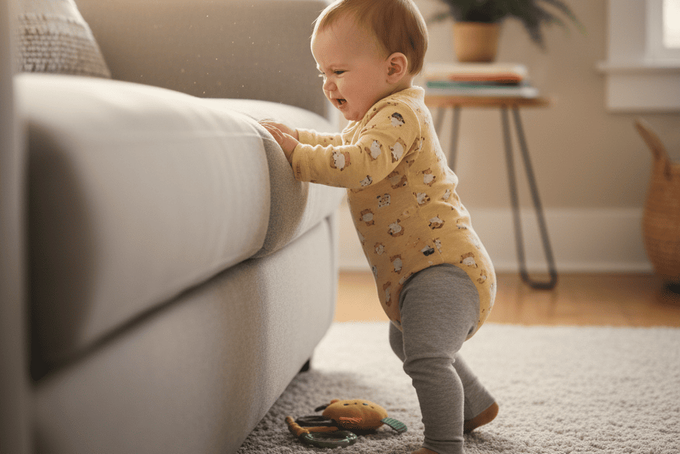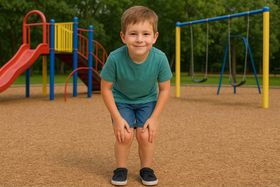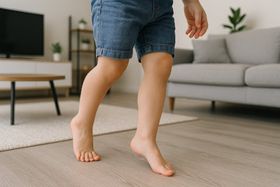Cruising Baby: How to Help Your Little One Find Their Balance
Cruising is when babies hold onto furniture to take supported steps, typically starting between 7-12 months. This guide explains what cruising means, how to create a supportive environment, practical exercises to build strength, and when to seek professional advice.
Published November 4, 2025
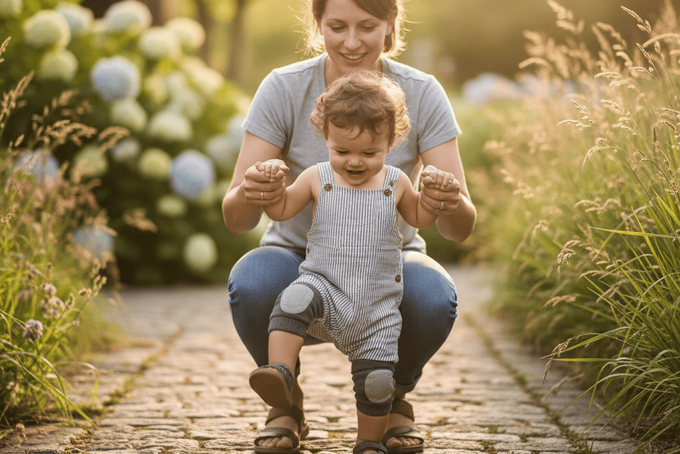
Watching your baby pull themselves up on the couch and take those first wobbly side steps is thrilling, and maybe a little nerve-wracking. But now you start wondering if your baby is progressing normally and how you can support your little one as they work toward independent walking.
The truth is that cruising looks different for every baby, and your child will reach this milestone on their own timeline. What matters most is creating an environment where they feel safe to explore and build confidence. Let's go over all you need to know about this gross motor developmental milestone.
What Is Cruising in Baby Development and Why Does It Matter?
Cruising means that your baby is holding onto objects, usually furniture, while standing and taking steps. Physiologically, cruising bridges the gap between crawling and walking by requiring different skills than crawling demands.
Your baby coordinates foot movements with hand movements along a supportive surface, taking sideways steps along stationary furniture or forward steps while pushing a wheeled toy.
This cruising milestone needs trunk muscle control to pull into a standing position and maintain balance while moving their legs [1].
Cruising is what developmental specialists call an "unstable posture", similar to kneeling and squatting, which means it demands more balance and coordination than crawling.
Why Balance Matters for Your Cruising Baby
Balance is the skill that separates cruising from crawling. During the cruising phase, your baby must maintain an upright position while shifting weight from one leg to another. This is usually something they didn't need to master while crawling on all fours.
Here's what healthy balance development looks like:
- Gradually increasing confidence and stability, as your baby might hold on tightly with both hands and take tentative side steps
- As trunk and leg muscles strengthen, they'll start letting go with one hand, carrying small toys, and taking bolder steps.
This progression happens because your baby's vestibular system, proprioception, and visual system are all maturing and learning to work together.
Keep in mind that wobbling, sitting down frequently, and even occasional tumbles are all normal parts of learning balance. Your baby isn't struggling if they have any distractions; they're learning.
When Do Babies Start Cruising and for How Long?
According to the World Health Organization, babies begin cruising between 7 and 12 months old, with most nine-month-olds achieving this milestone. That's a five-month range, which shows you just how much individual variation exists [2].
Family and cultural practices influence when cruising begins. Some cultures emphasize holding infants upright during activities like bathing, which research suggests may result in earlier walking ages.
The cruising phase lasts from several weeks to a few months. Keep in mind that with consistent support and encouragement, babies often progress more quickly.
One factor that I've noticed that consistently delays cruising is baby walkers. Walkers limit core muscle use and typically delay both cruising and independent walking [3]. Your baby needs to bear their own weight to build the necessary strength.
Now, this may sound worrying if your baby started cruising at 11 months instead of 8 months, but that doesn't predict anything about their athletic ability or coordination later. Late bloomers often catch up quickly once they start.
When to Seek Professional Advice About Your Cruising Baby
The WHO's 7-12 month range for cruising onset does account for normal developmental variation. But, you should consult your pediatrician or developmental specialist if you notice:
- No pulling to stand by 12 months. Your baby must grab supportive objects and pull into a standing position before cruising can start.
- No sitting independently by 8 months. Sitting demands sufficient trunk muscle strength to keep the upper body from falling over.
- History of prematurity. Babies born weeks before their due date often achieve motor milestones later than full-term infants.
These are guidelines that show where professional evaluation makes sense, and not because something is necessarily wrong. With this method, early intervention can address underlying issues if they exist.
Creating a Supportive Environment for Your Cruising Baby
Let's go over a few of the basics you'll need to create a safe and supportive space for your baby to cruise:
- You will first need to childproof for choking hazards and sharp edges, and focus on creating ideal cruising conditions.
- Secure all furniture that could tip. Your baby will grab anything within reach, like bookshelves, dressers, and television stands. Always anchor unstable furniture to walls using safety straps.
- Ensure furniture is sturdy enough to support your baby's full weight. Lightweight side tables and cushioned ottomans compress or slide when grabbed, failing to provide reliable leverage for cruising.
- Space support items strategically around the room. Create gaps that encourage your baby to move between cruising spots by briefly dropping to a squat or crawl, then pulling up again at the next furniture piece. This builds strength and problem-solving skills.
In clinical practice, babies usually show noticeable progress three to four weeks after parents increase floor playtime and optimize the environment. Your baby might start taking more steps per cruise, letting go with one hand more often, or attempting to transition between furniture pieces more confidently.
I always suggest being patient with the process. Your baby isn't being stubborn if progress feels slow. Their nervous system is literally building new connections with every practice session.
Environmental Factors That Affect Your Cruising Baby's Progress
There are many "invisible" environmental elements that affect your cruising baby's progression. For example, floor texture influences confidence—smooth hardwood provides predictable traction, while thick carpet can catch your baby's feet.
- Research shows that infants struggle with uneven flooring and gaps on walking surfaces, making continuous, flat surfaces essential during early cruising attempts [4].
- Lighting affects depth perception. Dim rooms make it harder for your baby to judge distances between furniture pieces.
- Visual clutter distracts and overwhelms. Too many toys or patterns pull your baby's attention away from the motor task at hand.
- Temperature and clothing bulk affect movement, too. Heavy winter clothing restricts your baby's range of motion. Some studies document delayed crawling and cruising among infants who regularly wear bulky clothing. During cold weather, ensure your baby gets floor playtime in lighter clothing.
How to Encourage Baby to Cruise and Then Walk
Specific exercises help your baby develop the muscle strength and coordination needed for cruising and eventual independent walking.
- Assisted pull-to-stand practice works well for younger babies. Hold your baby's hands while gently helping them pull into a standing position from sitting. This exercise teaches weight-bearing on legs and acclimates your baby to an upright position.
- Strategic toy placement encourages independent pulling up. Place interesting toys on chest-height surfaces—wooden toy boxes, sturdy step stools, or preschool-sized chairs. Your baby will crawl toward these objects and naturally attempt to pull up to reach them.
- Torso support during stepping builds confidence. Once your baby consistently pulls to stand, hold their torso (not hands) while they take steps and grab nearby furniture. This support level requires your baby to balance while building confidence.
Practiced regularly. Try to do daily floor playtime with opportunities for these activities. Most babies show improved balance, stability, and walking readiness within two to four weeks. You'll notice longer cruising sessions, more confident steps, and increased willingness to let go with one or both hands.
Choosing the Right Toys for Your Cruising Baby
Push toys are preferred over walkers or stationary bouncers. Gross motor skills can progress because babies need to use all of their muscles to push the toy. Walkers give excessive support to your baby's body weight and inhibit trunk muscle strengthening.
From what I've seen, after discontinuing walkers or jumpers, most babies show progress toward cruising or independent walking within one to two months. This shows that even if you've been using restrictive equipment, stopping now allows your baby to catch up quickly.
How Long After Cruising Do Babies Walk
Usually, it takes about a month or two to get a cruising baby to start walking, but this depends entirely on the child. After all, every baby is different and achieves their milestones differently.
How to Support a Baby to Start Walking
Some small shifts in daily routines can impact your cruising baby's motor development and get them to start walking:
Research shows that floor playtime with parents helps infants progress from crawling to cruising to independent walking [4]. You'll need to aim for multiple floor play sessions daily, totaling at least two to three hours.
Babies learn that there's better eye contact and social engagement in an upright position. This encourages them to stand and cruise. So, smile, offer outstretched arms, or hold an interesting toy just out of reach. Your baby will try to figure out the best movement strategy to reach you.
Babies are remarkably perceptive readers of how you feel. Frowns or worried looks may even discourage cruising and exploration. For this reason, if your baby cruises toward potential danger, calmly redirect their focus rather than reacting with alarm.
On the other hand, celebrating when your baby cruises or takes their first independent steps helps build confidence in their abilities.
Footwear Choices for Your Cruising Baby
Barefoot time strengthens your baby's foot muscles. Walking barefoot allows your baby's feet to grip the floor, provides maximum sensory feedback, and permits natural foot mechanics. For indoor cruising on safe surfaces, barefoot is ideal.
However, shoes serve important protective purposes for outdoor cruising or rough surfaces. When necessary, choose footwear for cruising that allows maximum unrestricted foot movement. Go for flexible soles, wide toe boxes, and minimal ankle restriction.
After making footwear adjustments and also increasing barefoot time, your little one will have stronger coordination and longer cruising sessions within two to three weeks.
The Lasting Benefits of Cruising for Baby
Cruising does more than prepare your baby for walking—it teaches them to work toward goals, understand spatial awareness, and navigate different surfaces. Most importantly, it builds the balance and coordination needed for independent steps.
Some babies cruise for weeks before walking, while others transition within days. Both timelines are completely normal. When your baby is ready for outdoor walking, proper footwear supports natural development. First Walkers orthopedic shoes, like Rex Roamers sandals and Johnny Rigel sneakers, provide grip and stability that new walkers need without restricting movement.
References
Adolph, K. E., Berger, S. E., & Leo, A. J. (2010). Developmental continuity? Crawling, cruising, and walking. Developmental Science, 14(2), 306–318. https://doi.org/10.1111/j.1467-7687.2010.00981.x
Department of Nutrition, World Health Organization. (2006). WHO Motor Development Study: Windows of achievement for six gross motor development milestones. In WHO (450: 86/95). Taylor and Francis. https://cdn.who.int/media/docs/default-source/child-growth/child-growth-standards/indicators/motor-development-milestones/who-motor-development-study-windows-of-achievement-for-six-gross-motor-development-milestones.pdf?sfvrsn=3425c1dc_0
Badihian, S., Adihian, N., & Yaghini, O. (n.d.). The Effect of Baby walker on Child Development: A Systematic review. https://pmc.ncbi.nlm.nih.gov/articles/PMC5703622/
CHOI, J., OGAWA, T., & TAKESUE, S. (n.d.). Different flooring surfaces affect infants’ crawling performance. https://pdf.sciencedirectassets.com/271441/1-s2.0-S0003687020X00135/1-s2.0-S0003687021002003/am.pdf
NHS. (n.d.). Information for families to encourage standing and walking. Ready Start Walk. https://www.rach.scot.nhs.uk/wp-content/uploads/2024/02/Ready-Steady-Walk-Parent-Booklet.pdf
Disclaimer: First Walkers' information is intended for educational and informational purposes related to toddler footwear and feet. We encourage you to consider individual circumstances and consult qualified orthopedists about specific conditions.
FAQs
When do babies start cruising furniture?
Most babies begin cruising between 7 and 12 months old, with the average baby achieving this milestone around 9 months. However, every baby develops at their own pace, and starting later doesn't indicate any problems.
How long after cruising do babies walk independently?
The duration varies widely. Some babies walk independently within a few weeks of starting to cruise, while others continue cruising for several months. Both timelines are normal. Consistent practice and encouragement can help, but every baby has their own developmental schedule.
Should my cruising baby wear shoes?
Barefoot is best for indoor cruising on safe surfaces because it strengthens foot muscles and provides better sensory feedback. Shoes are appropriate for outdoor surfaces or areas with potential foot hazards. Choose flexible, wide-toed shoes when footwear is necessary.
Should I worry if my baby isn't cruising by 10 months?
Not necessarily. The normal range is 7-12 months. However, consult your pediatrician if your baby shows no pulling-to-stand attempts by 12 months, isn't sitting independently by 8 months, or has a history of prematurity.

